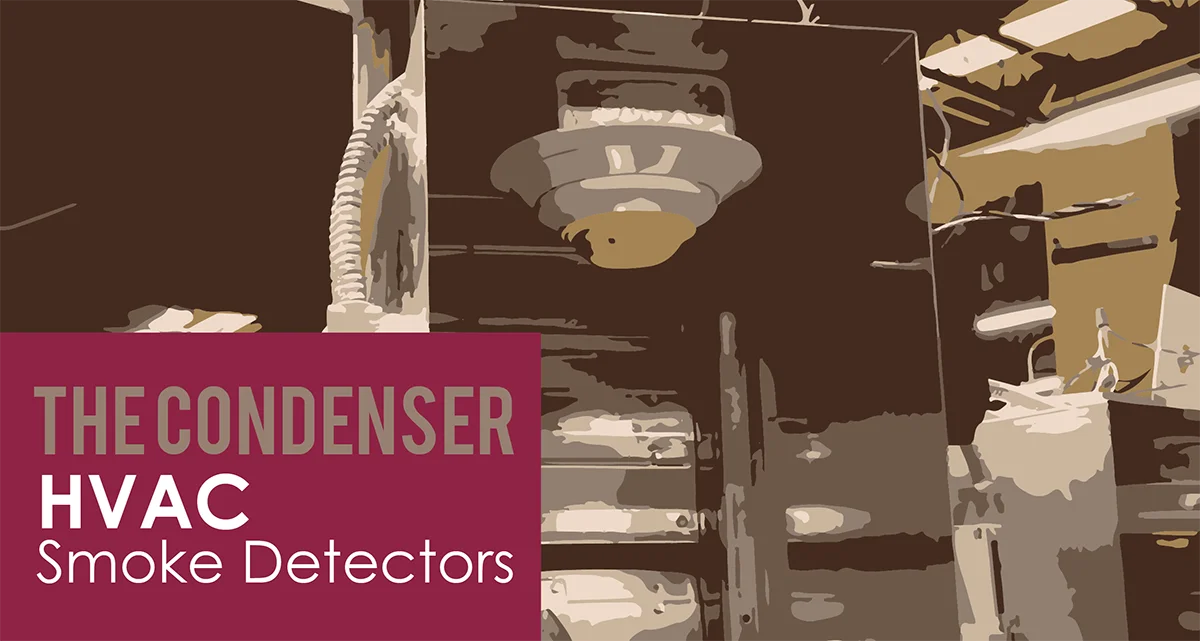Smoke dampers need the means to react quickly to the presence of smoke. Learn how HVAC smoke detectors work, and what to look for when choosing one, with the Condenser.
Smoke Detection in HVAC
Smoke detectors are required for smoke dampers and combination fire-smoke dampers. These dampers must be equipped to react to the first signs of noxious fumes in the air stream. HVAC smoke detectors are wired to the damper’s electric actuator. By default, the smoke detector will signal the damper to close when it detects the presence of smoke.
.webp?width=500&height=437&name=Hubspot%20Blog%202024%20-%20Smoke%20Detector%20-%20Installed%20(Resize).webp)
Flow or No-Flow?
There are two types of duct smoke detectors in HVAC: “flow” and “no-flow”. Flow detectors are typically mounted on the outside of the damper and utilize a sampling tube fed through the damper’s frame. This tube should be placed between the blades to sample the air as it flows through the open damper.
.webp?width=600&height=380&name=Hubspot%20Blog%202024%20-%20Smoke%20Detector%20-%20Flow%20(Resize).webp)
The smoke detector will trip when the tube detect smoke in the airstream and signal the actuator to close the damper. This is a “flow” detector because it requires air flow through the damper, so that the sampling tube can accurately detect smoke.
Local codes may require additional closure methods, such as zone detection. Contact your local authority having jurisdiction (LAHJ) to help determine the necessary configuration before installing.
No-flow detectors do not require airflow through the damper to detect the presence of smoke. These detectors have a round body and a sensor located at the top. They resemble smoke detectors commonly found in houses. No-flow detectors must be installed inside the damper’s frame, where the body of the detector is inside the damper.
The detector will be mounted to the top of the damper, situated away from the blades so that it doesn't block or hinder blade movement. Manufacturers will install the smoke detector at the factory.
.webp?width=600&height=320&name=Hubspot%20Blog%202024%20-%20Smoke%20Detector%20-%20No%20Flow%20(Resize).webp)
Once installed, no-flow detectors can sample the air even when system fans are off. However, the full detector will be in the air stream during operation. This will have a noticeable effect on the system’s air performance, versus the sampling tubes of the no-flow.
The National Fire Protection Association (NFPA) requires that internally mounted detectors have the means to be tested externally. Manufacturers, like Air Balance, can provide the necessary testing devices with additional instructions for installing and wiring these accessories.
Meet Requirements First
Each detector type has its benefits, but the project’s requirements will have the final say. It is important to understand your options when it comes to smoke control. Make sure your HVAC system is prepared for a fire event. Make sure each of your smoke dampers is equipped with the right smoke detector.
.webp?width=671&height=229&name=Hubspot%20Blog%202024%20-%20Smoke%20Detector%20-%20Models%20(Resize).webp)
Interested in passive fire protection? Looking for a damper with a specific fire resistance rating? Consider adding Air Balance fire-smoke dampers to your next project. At Air Balance, we build each damper to meet your project’s needs. Contact us today. We can help you meet your fire safety requirements with fire-smoke dampers.
Flow or no-flow? Which one do you think works best for a smoke damper? Tell us your thoughts in the comments section. We want to hear from you!
Read more about dampers and HVAC equipment with these Newsstand articles:
- Damper Dimensions
- The Condenser - Temperature Limits for HVAC Dampers
- Life Safety in HVAC - What is a Fire Damper?
.webp?width=91&height=70&name=MCDLG%20Logo%20(Resize).webp)






